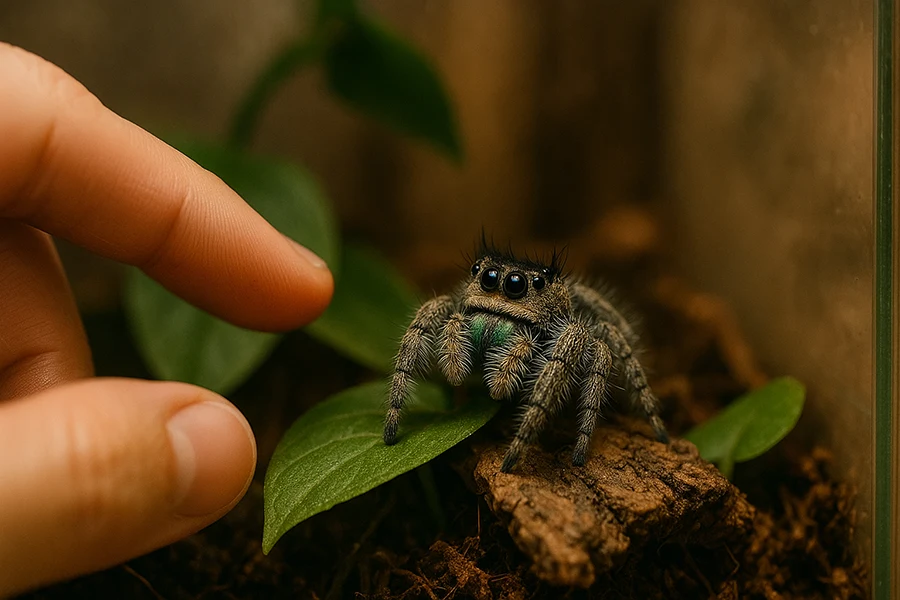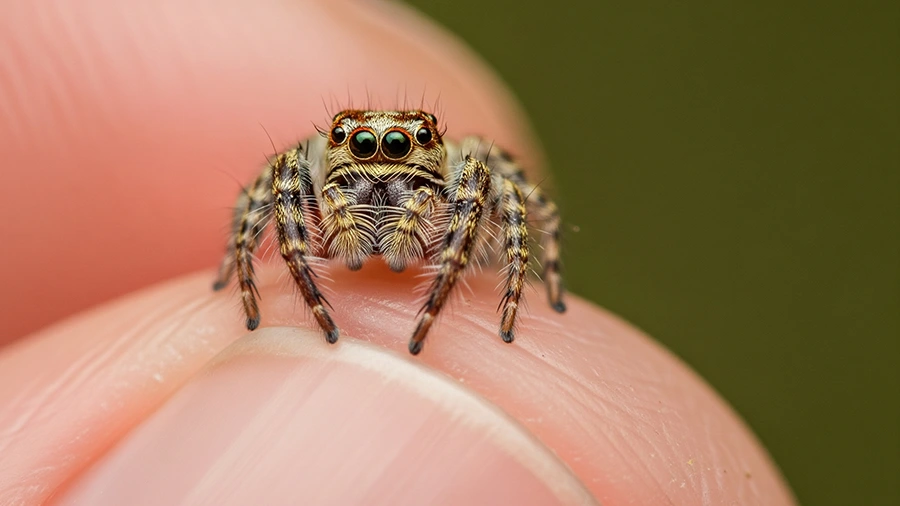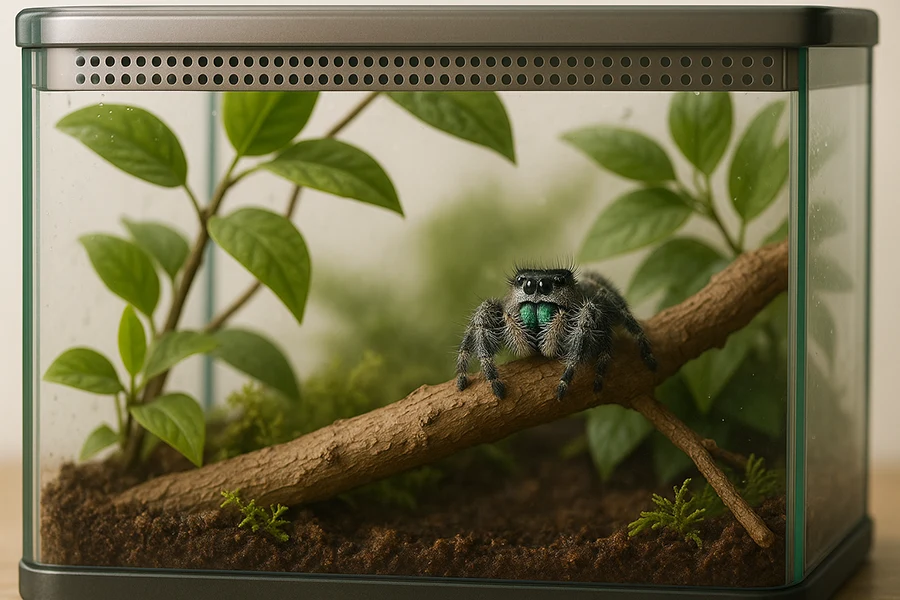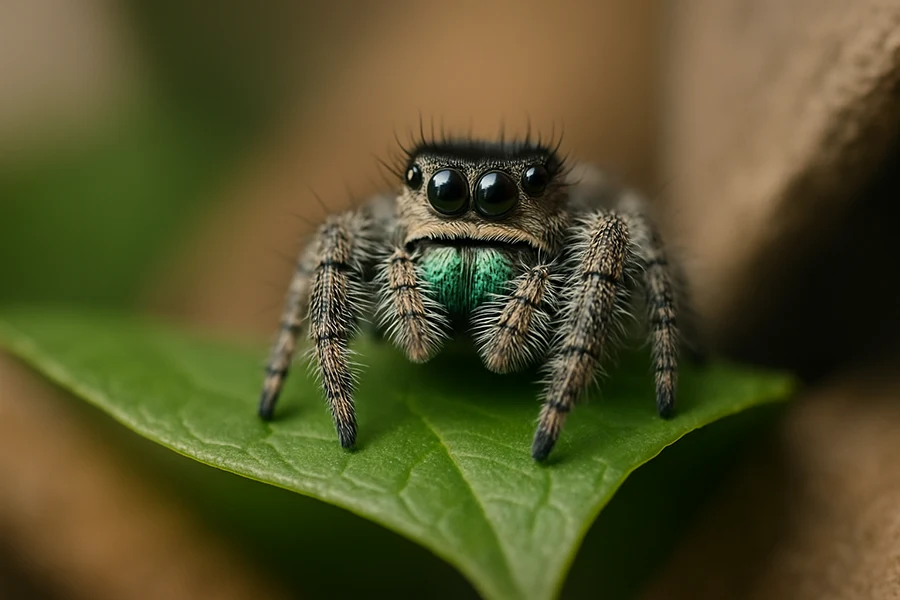How Long Does a Jumping Spider Live? A Personal Story + Life Expectancy Explained

In early 2023, I brought home a tiny unsexed sling — a Phidippus regius, better known as the regal jumping spider. She was in her 5th instar, still just a juvenile, no bigger than a speck on my fingertip. I didn’t know if she was male or female yet, but I had already fallen in love with her expressive eyes and curious little hops.
Everyone told me the same thing: “Don’t get too attached — jumping spiders don’t live very long.”
All the care sheets, forums, and articles echoed it: “They live up to a year, maybe a bit more if you’re lucky.”
But here’s the twist:It’s mid-2025 now, and she’s still alive.
Not just alive — but content, curious, and watching me as I write this.

So, How Long Does a Jumping Spider Live?
Jumping spiders typically live between 6 months and 3 years, depending on species, sex, and care conditions. So if you’re wondering:
- How long does a jumping spider live?
- How long can a jumping spider live?
- Jumping spider how long do they live?
- What is the longest living jumping spider ever recorded?
Here’s what I’ve learned — from both research and personal experience.
Breaking It Down: Species, Sex, and Maturity
The lifespan of a jumping spider can vary quite a bit:

🔸 Sex matters:
- Females generally live longer than males.
- After reaching maturity, females often live for another 12 months, sometimes more.
- Males, on the other hand, may only live 3 to 6 months after becoming adults.
- That said, there are exceptions. Some males surprise their owners and live close to a year after their final molt.
🔸 Species differences:
- My girl is a Phidippus regius — one of the more popular pet jumping spider species. Some owners report females living over 2 years, and the longest living jumping spider on record, a Phidippus audax (bold jumping spider), lived for 3 full years.
🔸 Molting stage (instars):
- Spiders grow by molting. My spider was at the 5th instar when I got her. Most Phidippus species reach maturity by the 7th or 8th instar, meaning she still had a lot of growing to do back then.
Why Is My Jumping Spider Still Alive After So Long?
Honestly? I think it’s a mix of care, genetics, and luck.
She’s never been “power-fed” — I fed her on a moderate schedule, once every 3-5 days, letting her metabolism flow naturally. Power-feeding, while it can speed up growth, often leads to earlier maturity and a shorter lifespan. Think of it like fast-forwarding their biological clock.
She also wasn’t overly active. She spent a lot of time perched quietly in her enclosure, watching the world go by. Maybe that slower pace helped extend her life?

How to Help Your Jumping Spider Live Longer
Want to extend your live jumping spider’s life as much as possible? Here are a few tips:
1. Don’t Overfeed
- Jumpers don’t need food every day.
- Feeding every 3–5 days for adults is plenty.
- Too much food = faster maturity = shorter life.
2. Optimal Enclosure Conditions
- Ensure good ventilation, proper humidity, and lots of climbing surfaces.
- Avoid stress — don’t tap the enclosure or disturb them, especially during molts.
3. Gentle, Minimal Handling
- Handling can be fun, but it can also be stressful for the spider, which may shorten their lifespan.
- Keep it to a minimum and always be gentle.
4. Keep Records
- Track molts, feedings, and behavior to understand their cycle better and spot any potential issues early.
Jumping Spider Life FAQ
Q: How long does a jumping spider live in captivity? A: On average, 1.5 to 2 years for females, while males live for a shorter period after maturing. With excellent care, some females can live up to 3 years.
Q: What’s the longest living jumping spider ever recorded? A: A female Phidippus audax lived for 3 years — quite a record!
Q: How long do jumping spiders live in the wild? A: Usually shorter than in captivity due to predators, weather, and inconsistent food sources. A lifespan of 6 months to 1 year is common.
Q: Can live jumping spiders be kept as pets? A: Absolutely! They are fantastic, low-maintenance pets with big personalities packed into a tiny body.
Q: Do jumping spiders die right after laying eggs? A: Not always. Many females can live for months after laying one or more egg sacs, depending on their health and species.

In Conclusion: A Life Well-Lived, One Jump at a Time
When I look at my spider now, approaching her third year of life, I realize that lifespan isn’t just about time — it’s about quality.
I gave her the best I could: a safe home, good food, and the space to just be a spider. And in return, she gave me the unexpected gift of time. A longer bond. A little miracle.
So if you’re wondering, “How long can a jumping spider live?” —
The answer is simple:Long enough to surprise you.
